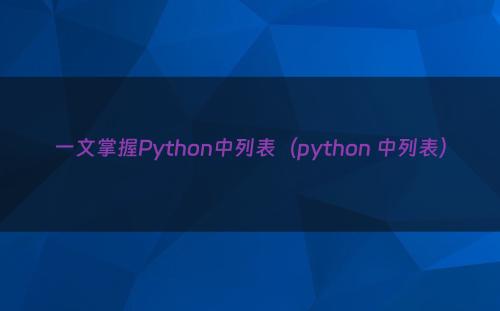创建列表
可以在Python中创建一个列表,方法是将一系列元素放在方括号( [] )中,用逗号分隔。
# Example of a list of numbers
numbers = [1, 2, 3, 4, 5]
# Example of a list of strings
fruits = ["apple", "banana", "cherry"]
# Example of a mixed-type list
mixed = [1, "hello", 3.14, True]元素访问
可以使用列表中的元素的索引来访问它们。第一个元素的索引从0开始。

numbers = [1, 2, 3, 4, 5]
first_element = numbers[0] # Output: 1
second_element = numbers[1] # Output: 2列表操作函数和方法
添加元素
可以使用各种方法向列表添加元素:
# Append: Adds an element to the end of the list
fruits = ["apple", "banana"]
fruits.append("cherry") # fruits is now ["apple", "banana", "cherry"]
# Insert: Adds an element at a specific index
fruits.insert(1, "orange") # fruits is now ["apple", "orange", "banana", "cherry"]扩展列表
将元素从另一个列表移到当前列表的末尾。
fruits = ["apple", "banana"]
more_fruits = ["cherry", "orange"]
fruits.extend(more_fruits) # fruits is now ["apple", "banana", "cherry", "orange"]更改项目值
fruits = ["apple", "banana", "cherry", "banana"]
fruits[1]="melon" # fruits is now ['apple', 'melon', 'cherry', 'banana']
fruits[1:3]=["pappaya","kiwi"] # fruits is now ['apple', 'pappaya', 'kiwi', 'banana']移除元素
可以使用各种方法从列表中删除元素:
# Remove: Removes the first occurrence of a value
fruits = ["apple", "banana", "cherry", "banana"]
fruits.remove("banana") # fruits is now ["apple", "cherry", "banana"]
# Pop: Removes and returns the element at a specific index
removed_element = fruits.pop(1) # removed_element is "cherry", fruits is now ["apple", "banana"]
# clear : Removes all elements from the list, making it empty.
fruits = ["apple", "banana", "cherry"]
fruits.clear() # fruits is now []
# del : deleting the elements or entire list
del mylist[0] # deleting the first elemet
del mylist # deleting the entire elemet复制列表
创建列表的副本。
fruits = ["apple", "banana", "cherry"]
copy_fruits = fruits.copy() # copy_fruits is a separate copy of fruits
# or
copy_fruits = fruits[:] # Another way to create a copy of the list逆转列表
反转列表中元素的顺序。
numbers = [1, 2, 3, 4, 5]
numbers.reverse() # numbers is now [5, 4, 3, 2, 1]排序列表
按升序对列表中的元素进行排序(默认情况下)。
numbers = [5, 1, 3, 2, 4]
numbers.sort() # numbers is now [1, 2, 3, 4, 5]
# Sorting in descending order
numbers.sort(reverse = True) # numbers is now [5, 4, 3, 2, 1]计数
返回指定值在列表中出现的次数。
numbers = [1, 2, 3, 4, 2, 2, 5]
count = numbers.count(2) # count is 3嵌套列表
嵌套列表是包含其他列表作为其元素的列表。这允许创建列表的列表,提供了一种表示更复杂数据结构的方法。在Python中,你可以嵌套列表来创建多维数据结构。
nested_list = [[1, 2, 3], [4, 5, 6], [7, 8, 9]]在这个例子中, nested_list 包含三个内部列表,每个列表代表一行数据:
[[1, 2, 3],
[4, 5, 6],
[7, 8, 9]]以下是如何在Python中使用嵌套列表:
nested_list = [[1, 2, 3], [4, 5, 6], [7, 8, 9]]
# Accessing elements
element = nested_list[1][1] # element is 5
# Modifying elements
nested_list[0][2] = 10 # nested_list is now [[1, 2, 10], [4, 5, 6], [7, 8, 9]]
# Adding a new inner list
new_inner_list = [11, 12, 13]
nested_list.append(new_inner_list)
# Removing an inner list
nested_list.remove([4, 5, 6])
# Displaying the nested list
for inner_list in nested_list:
print(inner_list)输出量:
[1, 2, 10]
[7, 8, 9]
[11, 12, 13]